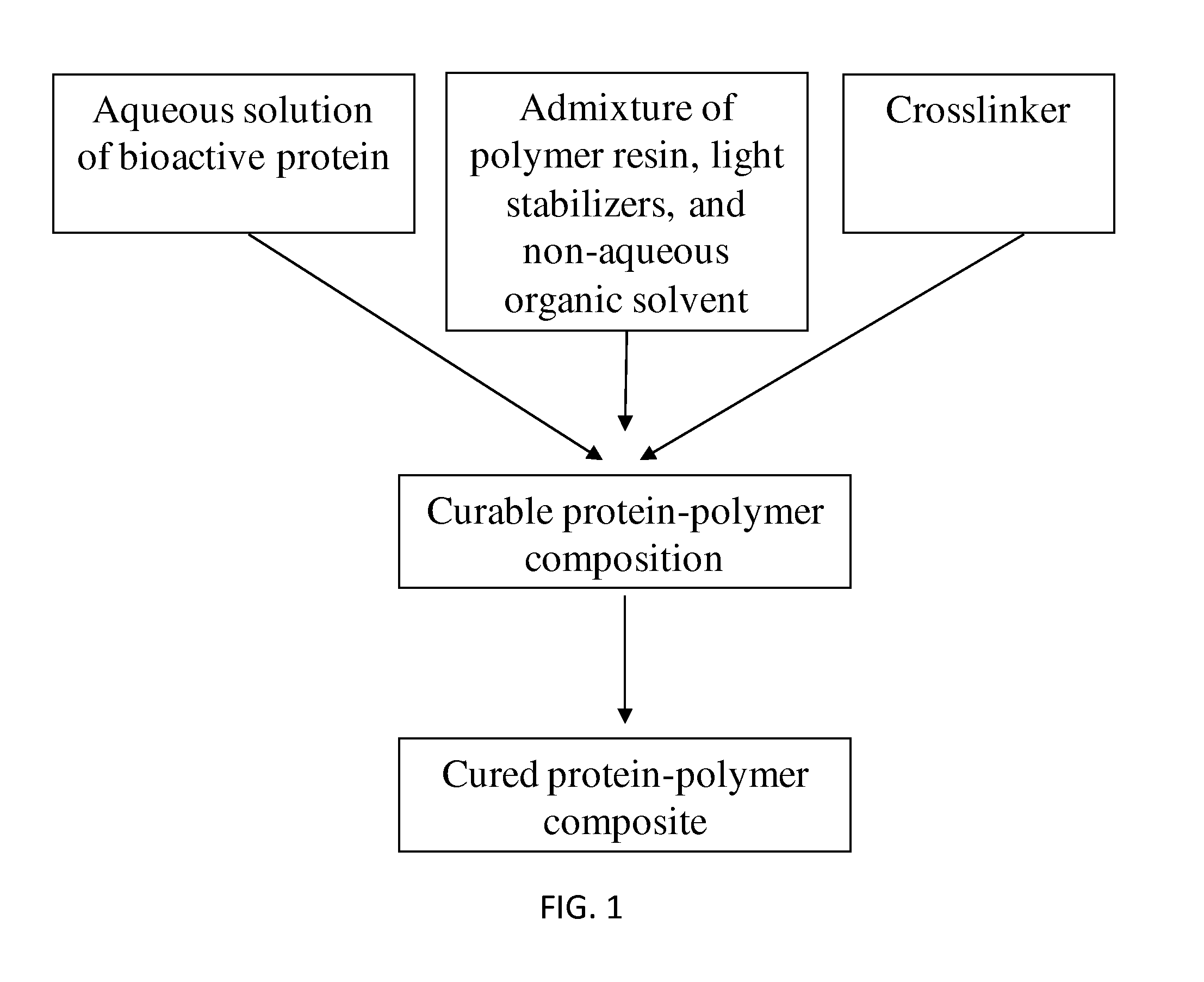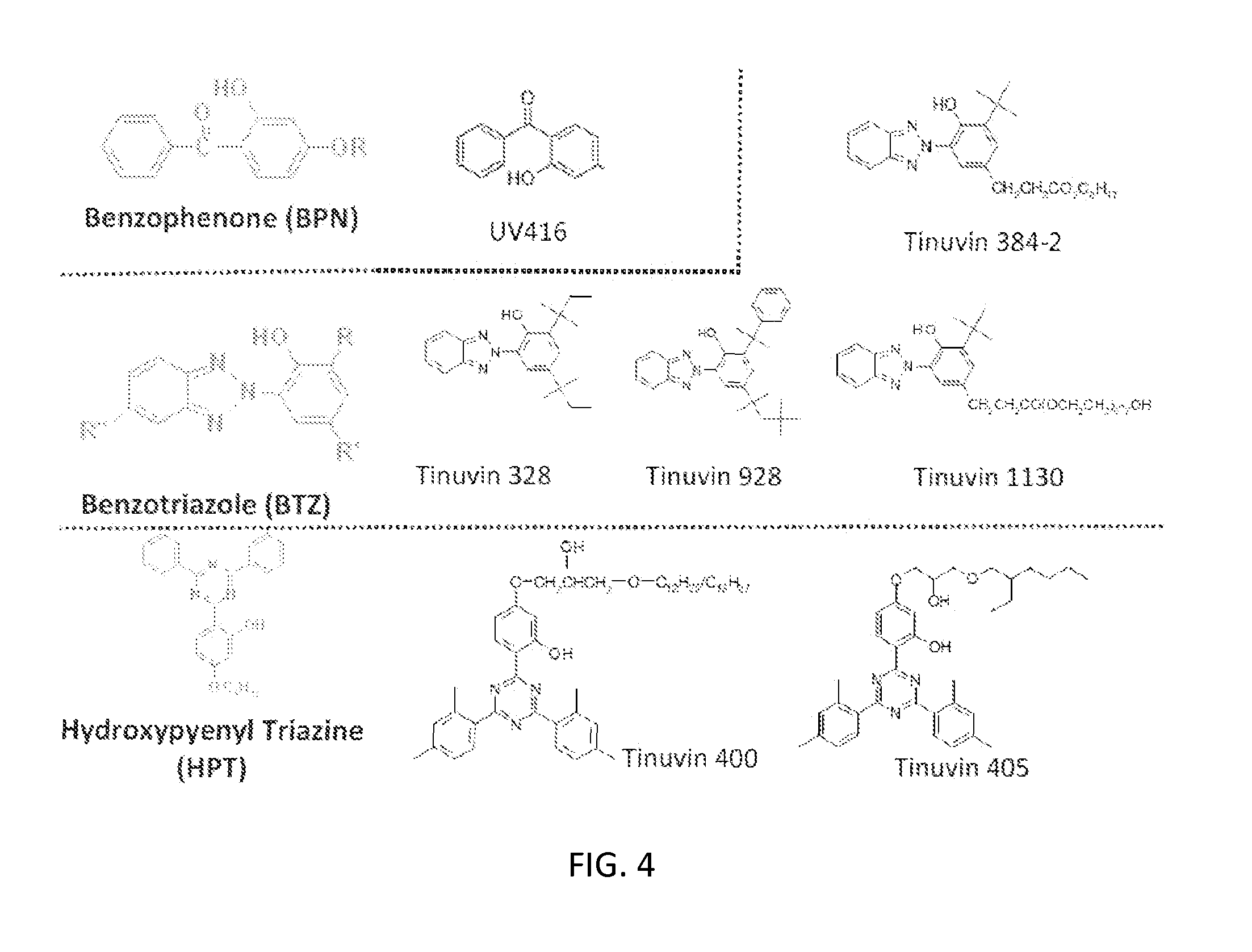UV-stabilized protein-polymer compositions
a technology of protein-polymer compositions and uv stabilization, which is applied in the field of coating compositions, can solve the problems of difficult removal, unpleasant marks on the surface deteriorating the appearance of products, and many outdoor surfaces being subject to stain or insul
- Summary
- Abstract
- Description
- Claims
- Application Information
AI Technical Summary
Benefits of technology
Problems solved by technology
Method used
Image
Examples
example 1
Preparation of Enzyme-Based Polyurethane Coatings
[0109]Materials: α-Amylase, Lipase PS, Protease N, Protease A, Protin SD AY-10, B. sterothermophilus TLP (Thermoase C160), and Thermoase GL30 (low activity preparation of B. sterothermophilus TLP) are obtained from AMANO Enzyme Inc. (Nagoya, JAPAN). Polyacrylate resin Desmophen A870 BA, and the crosslinker hexamethylene diisocyanate (HDI) based polyfunctional aliphatic polyisocyanate resin Desmodur N 3600 are obtained from Bayer Corp. (Pittsburgh, Pa.). The surfactant BYK-333 is obtained from BYK-Chemie (Wallingford, Conn.). 1-butanol and 1-butyl acetate are obtained from Sigma-Aldrich Co. (Missouri, USA). Aluminum paint testing panels are purchased from Q-Lab Co. (Cleveland, USA). All other reagents involved in the experiments are of analytical grade. Edge filters with visible long wave pass are obtained from Andover Co. (Salem, N.H.). UV absorbers Tinuvin 400, 328, 384-2, 928, 1150, and Hindered Amine Light Stabilizer (HALS) Tinuvin...
example 2
Wavelength Specific Enzyme Inactivation in Protein-Polymer Coatings
[0112]The coatings of Example 1 are applied to aluminum testing panels by the draw-down method of Example 1. The testing panels are subjected to different wavelength light by covering the coating with a long-wave-pass (LWP) filter. Several filters are used with a 50% transmission cut-off at 200, 283, 400, 500, or 600 nm. This divides the full spectrum of incoming light into several test wavelength range categories: 200-283 nm, 283-400 nm, 400-500 nm, and 500-600 nm and >600 nm. To specifically identify contribution of UV-light absent light from the visual spectrum, a test panel is covered with a filter having a 25% transmission peak at 350 nm and with an 80 nm bandpass. The test panels are subjected to light irradiation using a xenon lamp. The xenon lamp provides for a system that allows exposure to both heat and UV light whereby the light from the lamp closely mimics sunlight. The panels are placed in a weathering c...
example 3
Determination of Ideal UV Absorbers for Protection of Enzyme
[0119]Many different UV absorbers (UVA) are known in the art. A selection of UV absorbers are tested for their ability to block UV light within the desired wavelength range of 280 nm to 400 nm as determined to be the region of enzyme sensitivity in Example 2. The UV absorbers of FIG. 4 are dissolved in butyl acetate at a final concentration of 0.125 mg / ml, which corresponds to a 2% NV loading concentration when added to a 30 μm thick film of protein-polymer composition of Example 1. The dissolved UV absorbers are placed in a quartz cell with a 1 cm light path and analyzed on a scanning spectrophotometer for UV transmission. Each of the UV absorbers tested has a similar pattern of wavelength rejection described by a sharp decrease in UV transmission within the range from 350-400 nm. (FIG. 5) The cut-off values (10% transmission) for each of the tested UVAs is illustrated in FIG. 5A.
[0120]Different concentrations of the UVAs ...
PUM
 Login to View More
Login to View More Abstract
Description
Claims
Application Information
 Login to View More
Login to View More - R&D
- Intellectual Property
- Life Sciences
- Materials
- Tech Scout
- Unparalleled Data Quality
- Higher Quality Content
- 60% Fewer Hallucinations
Browse by: Latest US Patents, China's latest patents, Technical Efficacy Thesaurus, Application Domain, Technology Topic, Popular Technical Reports.
© 2025 PatSnap. All rights reserved.Legal|Privacy policy|Modern Slavery Act Transparency Statement|Sitemap|About US| Contact US: help@patsnap.com



